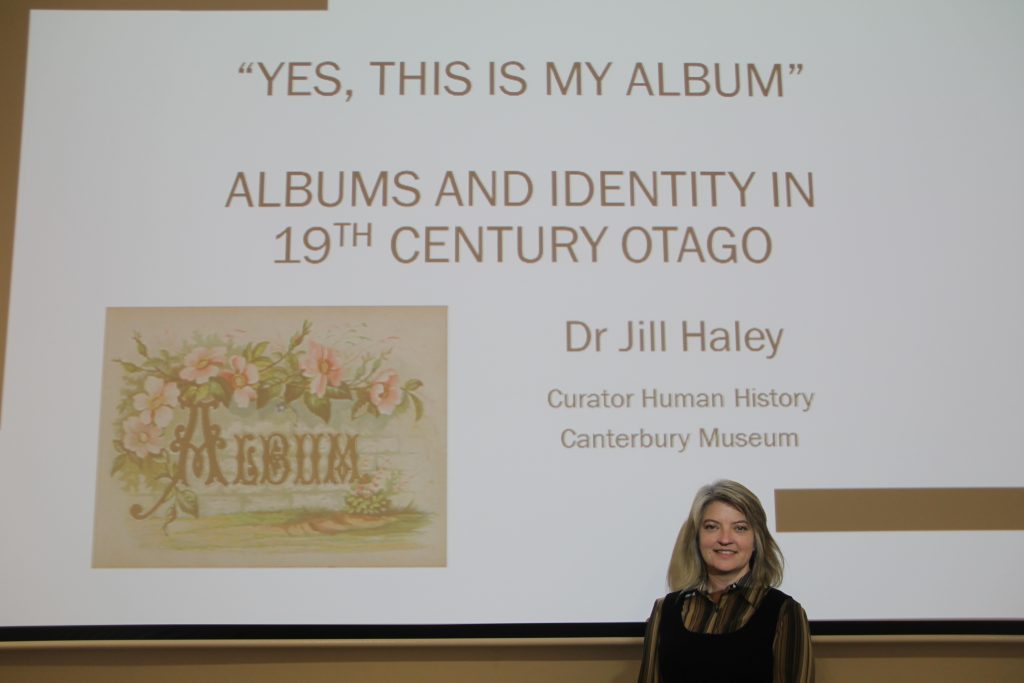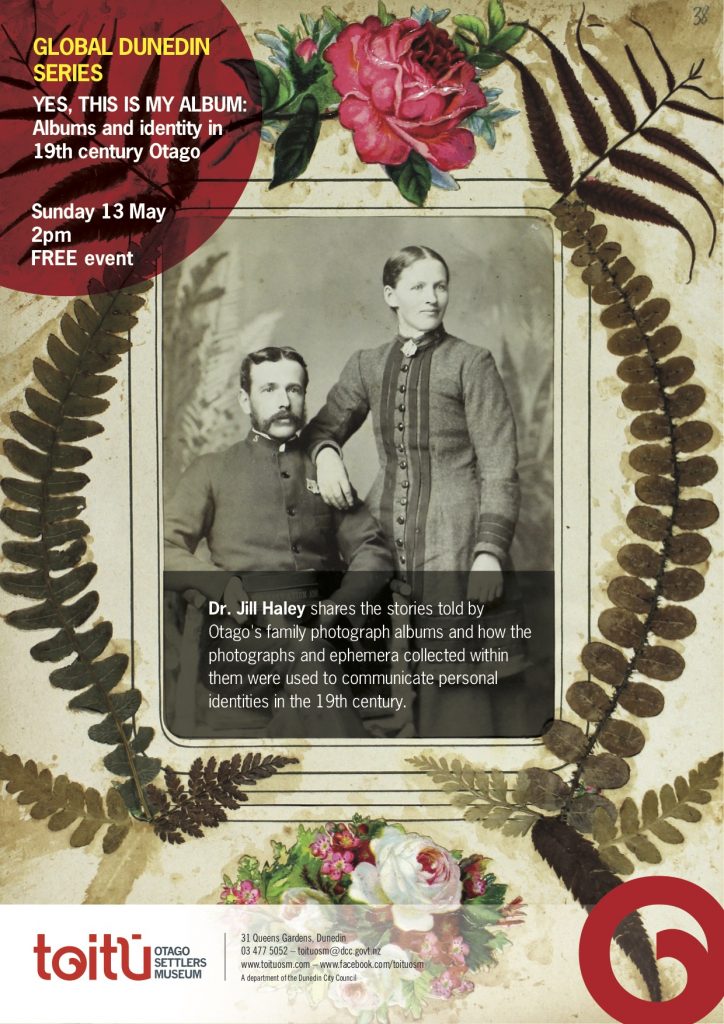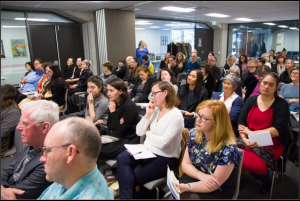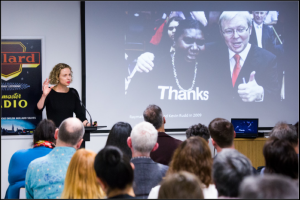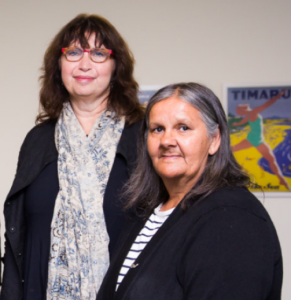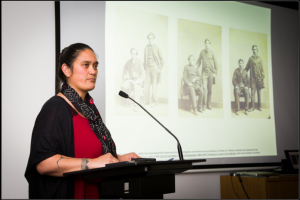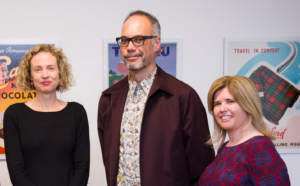Photography, Family Albums and the Making of Identity
In conjunction with Toitū Otago Settlers Museum, the Centre hosted the third lecture in the Global Dunedin Speaker Series on Sunday 13 May. Dr. Jill Haley, Curator Human History at Canterbury Museum, and a former archivist at Toitū, spoke to an attentive audience about album culture in colonial Otago and how engagement in this practice helped forge personal identity. In a richly illustrated talk, Jill discussed some the findings from her recent doctorate titled The Colonial Family Album: photography and identity in Otago, 1848-1890 (which can be downloaded from the University of Otago’s library here), which examined over 50 albums from Toitū’s collection. Although it might be assumed that albums were used by migrants to remember family and to assert familial connections to their former homes (whether Scotland, England or Ireland), instead the majority of album makers collected and displayed photographs that asserted their connections to their new home in the Otago colony. But album makers also included photographs that illuminated the global dimensions of their personal connections, including Priscilla Scott’s, which included images relating to places she visited with family, notably Peru, Hawaii and the United States. Increasingly, album makers also purchased photographs of local and international celebrities, as well as the the British Royal Family, for their collection.
Many thanks to Jill for a fantastic and illuminating talk that provided an insight into how the global practices of photography and album culture were shaped by local conditions and utilised to narrate personal identity.
Photography and Global Dunedin
The Centre’s monthly Global Dunedin Lecture Series resumes on Sunday 13 May with a talk by Dr. Jill Haley (Canterbury Museum), who will discuss the role of colonial photography and album-making in shaping the identities of Otago’s 19th century settlers. Jill’s talk will take place at Toitū’s Auditorium, starting at 2pm. All welcome!
Symposium: Collecting and Exhibiting Photography
Te Papa is hosting a symposium on photography in June. It costs $10 for the day-long event. To register click here.
Collecting and Exhibiting Photography
Saturday 11 June, 10am 5.15pm
Nga Toi, Level 5 and Rangimarie 1, Museum of New Zealand Te Papa Tongarewa
How do curators decide what photographs to exhibit and what to collect, and what are the ethical questions they consider? What are the implications of displaying non–art photography in an art museum? What is the significance of historical photographs in the age of digital photography? These questions and more are explored in this thought-provoking series of talks inspired by New Zealand Photography Collected.
Programme
10am–12pm: Keynote lecture and gallery walk-through
Leading art historian and photography curator Professor Geoff Batchen talks about New Zealand Photography Collected and issues related to photography curation. A walk through the exhibition with its curator, Athol McCredie, follows.
1.10pm–2.40pm: Panel – Collecting and exhibiting national collections
Panelists are Judy Annear, Senior Curator of Photographs at the Art Gallery of New South Wales, Shaune Lakin, Curator at the National Gallery Australia, and Ken Hall, Curator at Christchurch Art Gallery.
3.05pm–3.25pm: Lecture – The evolution of photography curation
Ron Brownson, Senior Curator at Auckland Art Gallery, explores how the curation of photography collections has changed. He also gives examples of contemporary artists who use photographic archives in their practice.
3.25pm–5.15pm: Panel – The ethics of exhibiting photography and photographic archives
The discussion is led by writer Dr Cassandra Barnett from Massey University Wellington, joined by Te Papa Pacific Cultures curator Nina Tonga, artist Fiona Amundsen, and Dr Clare Veal, an expert on the history of photography in Thailand.
Stimulating symposium on Indigenous Photographic Histories
Practitioners, curators, archivists, scholars and others flocked to the Indigenous Photographic Histories Symposium held at the National Library in Wellington on 5 November, an immensely successful one-day event co-organized by Paul Diamond (Alexander Turnbull Library), Angela Wanhalla (CROCC/University of Otago) and Jane Lydon (University of Western Australia, Perth).
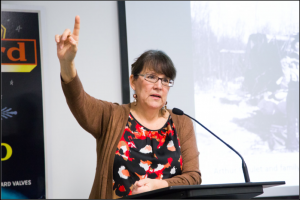
Keynote speaker: Professor Sherry Farrell Racette. Photo: Mark Beatty, Imaging Services, National Library
The symposium kicked off with two keynotes. The first, Professor Sherry Farrell Racette (Manitoba) on “Enclosing some Snapshots”: James P. Brady, Photography and Political Activism, showed how photography was such an integral part of the work of this well-known Métis activist. A self-taught community-based photographer, Brady used it record Metis life at a time when these communities were impoverished and its people lacked rights.
Professor Jane Lydon then gave Aboriginal Transformations of the Photographic Archive on how Aboriginal communities are now using historic photographs. She traced the emotional and healing properties of photographs, and echoing Sherry Farrell Racette’s keynote, pointed to the link between photography, rights and political activism. Drawing upon her Australian Research Council-funded project that identifies and returns Aboriginal photographs held in European collections, Jane noted that while photographs carry the burden of the colonial past, Aboriginal families see them as ways to connect with family and place. To read more about that ARC project have a look at the website: Returning Photographs: Australian Aboriginal Photographs from European Collections
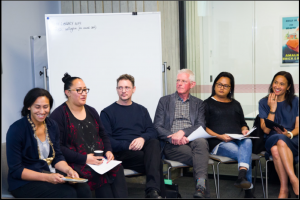
From left: Edith Amituanai, Nina Tonga, Brook Andrew, Paul McNamara, Yuki Kihara, and Jeanette Wikaira. Photo: Mark Beatty, Imaging Services, National Library
After morning tea, a panel of shorter talks ensued, first from three practitioners/artists: Edith Amituanai (Unitec), on the ethics of taking photographs in terms of her own work. Edith spoke about her community-based photography, recording Samoan people and their everyday lives in New Zealand and beyond. She gave us one of the most evocative sentences of the day when she described a photograph as an ‘incomplete utterance of a sentence’; Brook Andrew of Wiradjuri (Monash) discussed the complexities of representation, and his own obsession with the colonial archives, which he uses in his artwork; and Yuki Kihara gave a tour-de-force presentation on the intellectual work underpinning her recent “A Study of a Samoan Savage”, which was inspired by early “scientific” photographs of Samoans in the archive. These were followed by reflections from three people who deal with collections: Paul McNamara on how photographers had utilized the archives in various exhibitions at the McNamara Gallery in Whanganui; Nina Tonga, Te Papa’s Curator Pacific Cultures, on the photography of George Crummer, a trader in the Cook Islands from 1890; and Jeanette Wikaira, Kaituitui Ratonga Māori on how Kai Tahu families interact with the photographic archives of the Hocken Library.
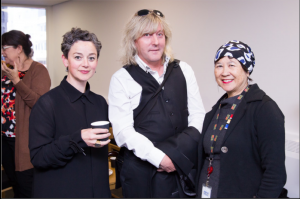
Helen Brown (left) enjoying a break in proceedings with Lyndon Fraser (Canterbury University), and Lynette Shum, Oral History Advisor at the Turnbull. Photo: Mark Beatty, Imaging Services, National Library
The suite of papers reflected on community, place and family. Natalie Robertson of AUT was unable to be at the symposium, but her Siting Mauri through Living Film and Photography using material relating to Ngāti Porou and the Waiapu River was wonderfully and elegantly presented for her by AUT doctoral candidate and photographer Ngahuia Harrison. Helen Brown of Ngai Tahu Archives presented on Wiremu Teira and his Māori Friends where she discussed the Pākehā writer and photographer William A. Taylor and his relationships with Ngāi Tahu communities.
New Zealanders are probably unaware that Aboriginal families, not allowed to live alongside white Australians were relegated to “fringe camps” on the outskirts of outback towns. Karen Hughes (Swinburne University) and renowned Ngarrindjeri weaver Aunty Ellen Trevorrow (Camp Coorong Race Relations Cultural Education Centre) showed life in Ngarrindgeri camps through the intimate and familial portraits made by Aboriginal women photographers.
Chanel Clarke, Māori Curator, Auckland Museum, rounded off the after-lunch session with Dressing the Part: Queen Victoria’s Māori Subjects, on the intersections of dress, photography and colonialism during a visit of Māori to England in the early 1860s. The symposium was lucky to have three “keynote listeners” who all gave their impressions and reflections on the earlier sessions: Damon Salesa (Auckland), Jo Smith (Victoria), and Tina Makereti (novelist, Curator Māori, Museums Wellington). All three touched upon several important themes that united all the presentations: the affective power of photography, the ethics of photography, the rich and varied methodologies being deployed, and the ongoing power of colonial images in the present day.
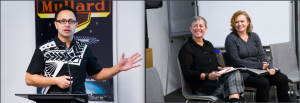
Wonderful “keynote listeners”: Damon Salesa, Jo Smith, and Tina Makereti. Photos: Mark Beatty, Imaging Services, National Library
It was wonderful to be exposed to insights from so many indigenous scholars and practitioners. It was also gratifying to hear how indigenous communities are now using the photographic archives, even those heavily underlain with the violence of colonialism, for their own purposes, as art, for rediscovering histories, and reconnecting communities.

